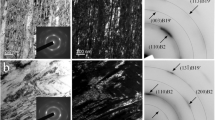Abstract
Ni-based amorphous wires with good bending ductility have been prepared for Ni75Si8B17 and Ni78P12B10 alloys containing 1 to 2 at. pct Al or Zr by melt spinning in rotating water. The enhancement of the wire-formation tendency by the addition of Al has been clarified to be due to the increase in the stability of the melt jet through the formation of a thin A12O3 film on the outer surface. The maximum wire diameter is about 190 to 200 μm for the Ni-Si (or P)-B-Al alloys and increases to about 250 μm for the Ni-Si-B-Al-Cr alloys containing 4 to 6 at. pct Cr. The tensile fracture strength and fracture elongation are 2730 MPa and 2.9 pct for (Ni0.75Si0.08B0.17 99Al1) wire and 2170 MPa and 2.4 pct for (Ni0.78P0.12B0.1)99Al1 wire. These wires exhibit a fatigue limit under dynamic bending strain in air with a relative humidity of 65 pct; this limit is 0.50 pct for a Ni-Si-B-Al wire, which is higher by 0.15 pct than that of a Fe75Si10B15 amorphous wire. Furthermore, the Ni-base wires do not fracture during a 180-deg bending even for a sample annealed at temperatures just below the crystallization temperature, in sharp contrast to high embrittlement tendency for Fe-base amorphous alloys. Thus, the Ni-based amorphous wires have been shown to be an attractive material similar to Fe- and Co-based amorphous wires because of its high static and dynamic strength, high ductility, high stability to thermal embrittlement, and good corrosion resistance.
Similar content being viewed by others
References
M. Hagiwara, A. Inoue, and T. Masumoto:Metall. Trans. A, 1982, vol. 13A, p. 373.
A. Inoue, M. Hagiwara, and T. Masumoto:J. Mater. Sci., 1982, vol. 17, p. 580.
M. Hagiwara, A. Inoue, and T. Masumoto:Mater. Sci. Eng., 1982, vol. 54, p. 197.
T. Masumoto, I. Ohnaka, A. Inoue, and M. Hagiwara:Scripta Metall., 1981, vol. 15, p. 293.
A. Inoue, Y. Masumoto, N. Yano, A. Kawashima, K. Hashimoto, and T. Masumoto:J. Mater. Sci., 1985, vol. 20, p. 97.
A. Inoue, N. Yano, and T. Masumoto:J. Mater. Sci., 1984, vol. 19, p. 3786.
I. Ohnaka, T. Fukusako, and T. Daido:J. Japan Inst. Metals, 1981, vol. 45, p. 751.
H.S. Chen, R.C. Sherwood, S. Jin, G.C. Chi, A. Inoue, T. Masumoto, and M. Hagiwara:J. Appl. Phys., 1984, vol. 55, p. 1796.
K. Mohri, J. Yamasaki, and T. Kondo:Proc. 5th Int. Conf. on Rapidly Quenched Metals, North-Holland, Amsterdam, 1985, p. 1659. 10. H. Matuski and K. Murakami:IEEE Trans. Magnetics, 1985, vol. MAG-21, p. 1738.
M. Hagiwara: Unitika, Ltd., 611 Japan, unpublished research, 1984.
Commercial Catalog, Unitika Ltd., Uji 611, Japan, 1984.
M. Hagiwara, A. Inoue, and T. Masumoto:Metall. Trans. A, 1981, vol. 12A, p. 1027.
M. Hagiwara, A. Inoue, and T. Masumoto:Sci. Rep. Res. Inst. Tohoku Univ., 1981, vol. 29A, p. 351.
T. Masumoto, A. Inoue, M. Hagiwara, I. Ohnaka, and T. Fukusako:Proc. 4th Int. Conf. on Rapidly Quenched Metals, T. Masumoto and K. Suzuki, eds., Japan Inst. Metals, Sendai, 1981, p. 47.
M. Hagiwara, A. Inoue, and T. Masumoto:Proc. 5th Int. Conf. on Rapidly Quenched Metals, North-Holland, Amsterdam, 1985, p. 1779.
A. Inoue, H. S. Chen, J. T. Krause, and T. Masumoto:J. Non-Cryst. Solids, 1984, vol. 61/62, p. 949.
A. Inoue, T. Masumoto, M. Hagiwara, and H. S. Chen:Scripta Metall., 1983, vol. 17, p. 1205.
H. S. Chen:J. Appl. Phys., 1978, vol. 49, p. 3289.
A. Inoue, H. S. Chen, J. T. Krause, T. Masumoto, and M. Hagiwara:J. Mater. Sci., 1983, vol. 18, p. 2743.
H.S. Chen, J. T. Krause, A. Inoue, and T. Masumoto:Scripta Metall., 1983, vol. 17, p. 1413.
A. Inoue, T. Masumoto, M. Hagiwara, and H. S. Chen:Scripta Metall., 1983, vol. 17, p. 1205.
A. Inoue, H. S. Chen, and T. Masumoto:J. Non-Cryst. Solids, 1984, vol. 61/62, p. 949.
A. Inoue, T. Masumoto, and N. Yano:J. Mater. Sci., 1984, vol. 19, p. 3786.
Y. Ishihara: private communication, Hitachi Research Laboratory, Hitachi Ltd., Hitachi 317, Japan, August 1981.
T. Egami, P.J. Flanders, and C. D. Graham, Jr.:AIP Conf. Proc., 1975, vol. 24, p. 697.
T. Masumoto, Y. Waseda, H. M. Kimura, and A. Inoue:Sci. Rep. Res. Inst. Tohoku Univ., 1976, vol. A26, p. 21.
H. S. Chen:Mater. Sci. Eng., 1976, vol. 26, p. 79.
M. Hagiwara, A. Inoue, and T. Masumoto:Proc. of the 4th Int. Conf. on Rapidly Quenched Metals, T. Masumoto and K. Suzuki, eds., The Japan Inst. Metals, Sendai, 1982, p. 1373.
A. Inoue, T. Masumoto, and H. M. Kimura:J. Japan Inst. Metals, 1978, vol. 42, p. 303;Sci. Rep. Res. Inst. Tohoku Univ., 1979, vol. A27, p. 159.
Author information
Authors and Affiliations
Rights and permissions
About this article
Cite this article
Inoue, A., Furukawa, S., Hagiwara, M. et al. Preparation, mechanical strengths, and thermal Stability of Ni-Si-B and Ni-P-B Amorphous Wires. Metall Trans A 18, 621–628 (1987). https://doi.org/10.1007/BF02649477
Received:
Published:
Issue Date:
DOI: https://doi.org/10.1007/BF02649477




